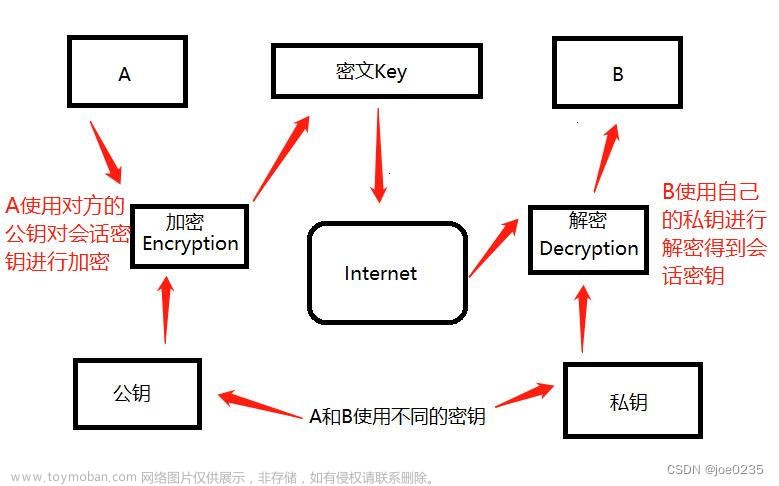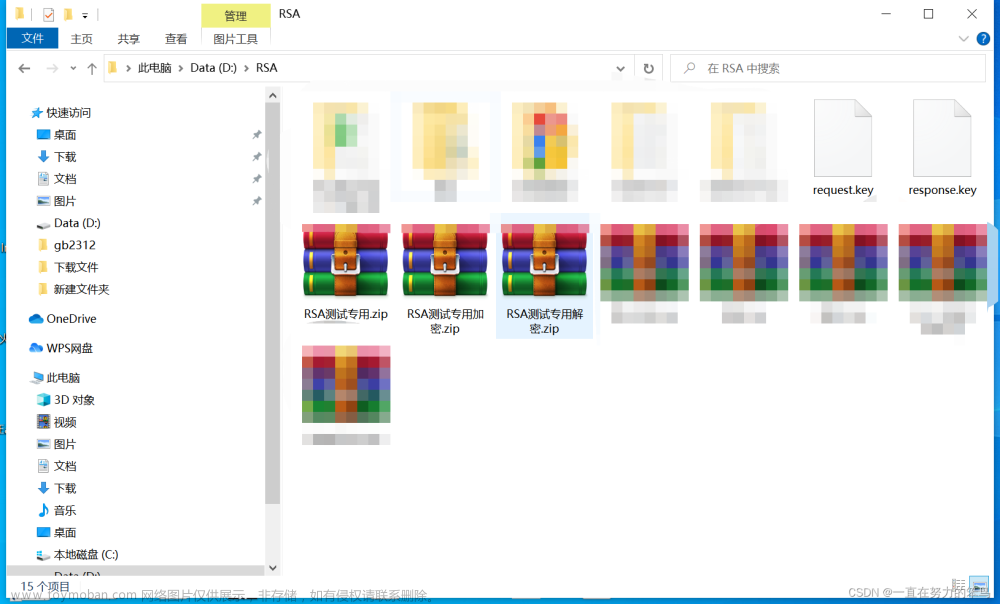实际项目中,前后端或跨语言加密通讯的场景十分常见。这里以 Java 和 Node.js(兼容浏览器)两种开发语言为例,实现 RSA 加解密通讯。
JAVA端加解密
此代码采用分段加解密,理论上支持无限长度的文本内容文章来源:https://www.toymoban.com/news/detail-723831.html
import javax.crypto.Cipher;
import java.io.ByteArrayOutputStream;
import java.security.*;
import java.security.spec.PKCS8EncodedKeySpec;
import java.security.spec.X509EncodedKeySpec;
import java.util.Base64;
public final class RSAProvider {
private final static String RSA = "RSA";
private final static String SHA256WithRSA = "SHA256WithRSA";
private final static int MAX = 117;
private String privateKey;
private String publicKey;
/**
* 创建 RSA 工具类,自动生成公私钥(字符串格式)
* @throws Exception
*/
public RSAProvider() throws Exception {
//自动生成密钥
KeyPairGenerator generator = KeyPairGenerator.getInstance(RSA);
generator.initialize(1024, new SecureRandom());
KeyPair keyPair = generator.genKeyPair();
Base64.Encoder encoder = Base64.getEncoder();
initKey(
encoder.encodeToString(keyPair.getPublic().getEncoded()),
encoder.encodeToString(keyPair.getPrivate().getEncoded())
);
}
/**
* 使用特定公私钥初始化工具类
* @param pubKey
* @param priKey
*/
public RSAProvider(String pubKey, String priKey){
initKey(pubKey, priKey);
}
private void initKey(String pubKey, String priKey){
this.privateKey = priKey;
this.publicKey = pubKey;
}
private PrivateKey buildPriKey() throws Exception {
if(privateKey == null || privateKey.isEmpty()) throw new RuntimeException("PRIVATE KEY is empty!");
return KeyFactory.getInstance(RSA)
.generatePrivate(
new PKCS8EncodedKeySpec(Base64.getDecoder().decode(privateKey))
);
}
private PublicKey buildPubKey() throws Exception {
if(publicKey == null || publicKey.isEmpty()) throw new RuntimeException("PUBLIC KEY is empty!");
return KeyFactory.getInstance(RSA)
.generatePublic(
new X509EncodedKeySpec(Base64.getDecoder().decode(publicKey))
);
}
/**
* 使用私钥签名
* @param content
* @return
*/
public String sign(String content) throws Exception {
Signature signature = Signature.getInstance(SHA256WithRSA);
signature.initSign(buildPriKey());
signature.update(content.getBytes());
return Base64.getEncoder().encodeToString(signature.sign());
}
/**
* 公钥验签
* @param message
* @param signed
* @return
* @throws Exception
*/
public boolean verifySign(String message, String signed) throws Exception {
Signature signature = Signature.getInstance(SHA256WithRSA);
signature.initVerify(buildPubKey());
signature.update(message.getBytes());
return signature.verify(Base64.getDecoder().decode(signed));
}
/**
* 使用公钥加密
* @param content 任意长度的字符
* @return
*/
public String encrypt(String content) throws Exception {
Cipher cipher = Cipher.getInstance(RSA);
cipher.init(Cipher.ENCRYPT_MODE, buildPubKey());
//此方法只能加密长度小于 117 bytes
// return Base64.getEncoder().encodeToString(cipher.doFinal(content.getBytes()));
byte[] bytes = content.getBytes();
ByteArrayOutputStream bops = new ByteArrayOutputStream();
int offLen = 0;
while (bytes.length - offLen > 0){
bops.write(cipher.doFinal(bytes, offLen, Math.min(bytes.length - offLen, MAX)));
offLen += MAX;
}
bops.close();
return Base64.getEncoder().encodeToString(bops.toByteArray());
}
/**
* 使用私钥解密
* @param data 任意长度的密文(分段解密)
* @return
* @throws Exception
*/
public String decrypt(String data) throws Exception {
Cipher cipher = Cipher.getInstance(RSA);
cipher.init(Cipher.DECRYPT_MODE, buildPriKey());
// 此方法报错:Data must not be longer than 128 bytes
// return new String(cipher.doFinal(Base64.getDecoder().decode(data)));
byte[] bytes = Base64.getDecoder().decode(data);
ByteArrayOutputStream bops = new ByteArrayOutputStream();
int offLen = 0;
while (bytes.length - offLen > 0){
bops.write(cipher.doFinal(bytes, offLen, Math.min(bytes.length - offLen, 128)));
offLen += 128;
}
bops.close();
return bops.toString();
}
public String getPrivateKey() {
return privateKey;
}
public String getPublicKey() {
return publicKey;
}
}
使用示例:文章来源地址https://www.toymoban.com/news/detail-723831.html
RSAProvider().also {
println("公钥:${it.publicKey}")
println("私钥:${it.privateKey}")
val text = "Hello,集成显卡!!"
val miwen = it.encrypt(text)
println("密文:${miwen}")
println("解码:${it.decrypt(miwen)}")
}
Node/JavaScript 加解密
// 请先执行 npm i node-rsa
const NodeRSA = require("node-rsa")
const encryptionScheme = "pkcs1"
module.exports = {
encrypt (data, publicKey) {
const pubKey = new NodeRSA(publicKey, 'pkcs8-public')
//设置与后端一致的加密方式 pkcs1
pubKey.setOptions({ encryptionScheme })
return pubKey.encrypt(Buffer.from(data), 'base64')
},
decrypt (data, privateKey){
const priKey = new NodeRSA(privateKey, 'pkcs8-private')
priKey.setOptions({ encryptionScheme })
return priKey.decrypt(Buffer.from(data, 'base64'), 'utf8')
},
sign (data, privateKey){
const priKey = new NodeRSA(privateKey, 'pkcs8-private')
return priKey.sign(Buffer.from(data)).toString('base64')
},
verify (data, signature, publicKey){
const pubKey = new NodeRSA(publicKey, 'pkcs8-public')
return pubKey.verify(data, Buffer.from(signature, 'base64'))
}
}
到了这里,关于JAVA+Node/JavaScript 前后端通讯 RSA 加解密实现的文章就介绍完了。如果您还想了解更多内容,请在右上角搜索TOY模板网以前的文章或继续浏览下面的相关文章,希望大家以后多多支持TOY模板网!










